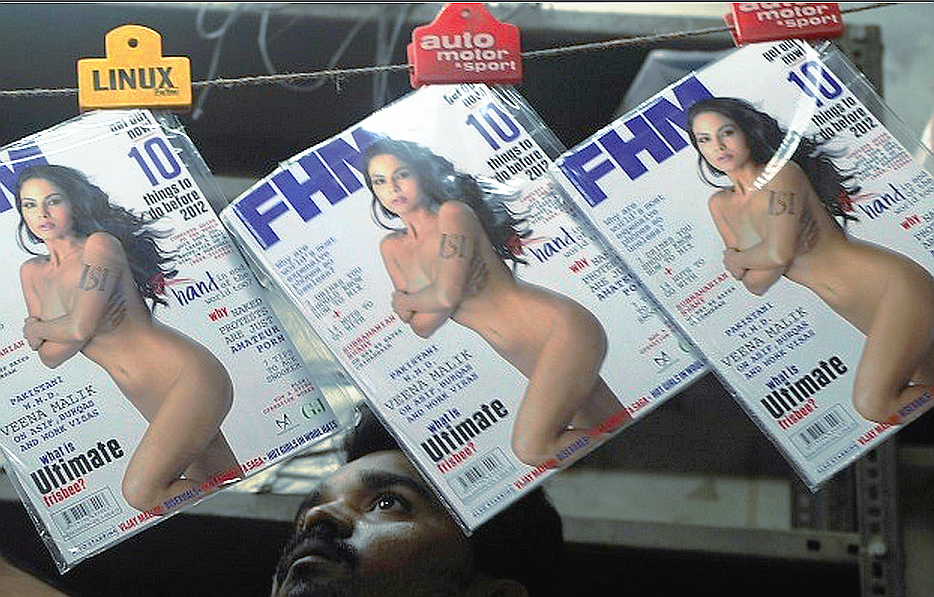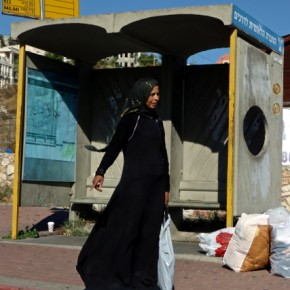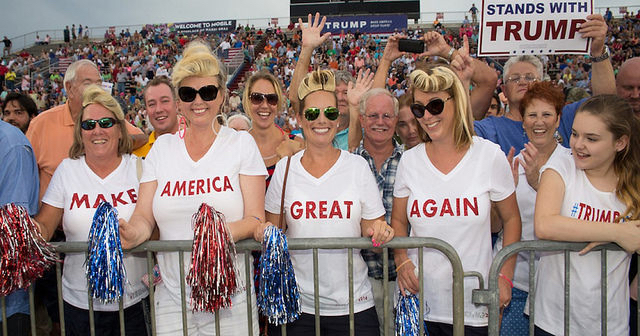It was a cathartic moment. Actress and model Veena Malik was subjected to an exhausting interview by an aggressive journalist, as well as hardline mufti Abdul Qawi, on Express News TV. The two men were fiercely critical of Malik’s behavior during season four of the Indian reality program Bigg Boss, during which she was boldly sexual with Indian co-star Ashmit Patel. Rather than collapsing under pressure, Malik lashed back, asking a question that has been in the minds of Pakistani progressives for some time: “Mufti saab, yeh kya baat hui?” This loosely translates to, “mufti sir, what is your problem?”
Malik would attract controversy again with a soft pornographic spread in the December 2011 issue of FHM India. Just this month, there were new protests by the far-right Hindu group Sri Rama Sena, though, these protests were less about Malik’s sexual conduct and more about Pakistanis working in Bollywood. All this raises an important question: why do Pakistanis care what Veena Malik does with her hot body? Since people apparently do, what does that mean?
The Express News interview instantly propelled Malik to a position of respect among Pakistan’s often disenchanted progressive community. It also had the effect of definitively humiliating the hyper-normative assertion that Malik committed an offense against Islam and Pakistan (essentially arguing that blasphemy and treason are synonymous) by wearing short skirts and hooking up with an Indian. This sprang from Malik’s behavior during the interview itself: firm, passionate, and unwilling to allow herself to be attacked for expressing herself sexually. She also asked a fiercely conservative religious leader, in a country that ranks 123 out of 148 countries on the Human Development Report’s Gender Inequality Index, if it’s easier to pick on women because they are a “soft target.”
This remains a vital question that faces Pakistani women. It must be approached with care. However, what can be stated outright is that Malik’s controversies continue to be worth discussing because they have outed significant Pakistani social failings when it comes to gender.
One is the reluctance of many self-identified feminists to support a figure that profits from the male gaze. There is a deep and often heated discourse about whether or not sex workers (which included Malik, while she was modeling for FHM India) can be considered a part of the Pakistani feminist tradition.
Many feminists (although it can be argued that there is an emerging generational divide about this) continue to hold the belief that pornography has no place in feminism. There were Pakistani feminists who attacked Malik along these lines, arguing that although they supported her right to pose in FHM India, they also did not want her identified with Pakistani feminism because of it.
It is true that FHM India isn’t exactly a positive force when it comes to gender. Among its many problematic and sexist qualities is a purposeful tendency to feature light-skinned models, which admittedly includes Malik herself. This is important in a South Asian magazine, because the loose color consciousness that accompanied the pre-colonial caste system intersected with British imperialism quite decisively. By the end of the British Raj, most South Asians had been indoctrinated with the belief that whiter skin (not coincidentally that which their Anglo-Saxon rulers possessed) deserved its position at the highest order of social power. Even (and perhaps especially) in the post-colonial era, this trauma is still present, such as through a massively popular skin-lightening cream industry that Westerners often make the mistake of equating with the social trend of tanning. It means something very violent that a magazine that purports to photograph the world’s most attractive women excludes South Asians who have darker skin.
However, deliberately separating Veena Malik from Pakistani feminism (and this still happens for updated reasons) because she modeled for a magazine that crudely called her “Pakistan’s W.M.D.” continues to strike me as strange. Apart from being sex-negative, many Pakistanis are overlooking the crucial detail that objectification by men hinges on questions of consent and female sexual agency.

While some Pakistani feminists such as Urooj Zia were supportive of Malik defiantly flaunting her sexuality, others continue to reject Malik because they believe that she is too sexually provocative to be associated with an ideology of feminist liberation. Malik hasn’t self-identified as a feminist to date, instead reiterating that she is only an entertainer. However, it strikes me as remarkably closed-minded to dismiss a woman who has bravely defended her bodily agency simply because of a disagreement with how that agency has exercised itself. There are firm materialist debates to be had about Malik’s career options, but an unfortunate amount of the backlash was centered in Islamic morality, which begs the question of why Pakistanis aren’t more accepting.
Feminism, should not be limited by is limited by essentialist definitions of femininity, as often occurs in Pakistan. Women must be able to defend their sexual agency in a variety of different ways, including behavior that smacks of objectification. I do not believe that Malik’s FHM India photographs, and the expressions of her sexuality since then, are all too different from Pakistani women who state that they wear headscarves or burqas out of personal conviction. Certainly, one can dismiss such clothing on ideological grounds. Nevertheless, it’s also possible to find, in their usage, feminist moments, too. And if the argument is that these discussions of individual agency are irrelevant to discussions of patriarchy, then discourse must adapt to the fact that gender issues are at once intensely public and personal, and must push against repression in both spheres. Part of that likely includes stripping away the male economic dominance that occurs in Malik’s industry.
Another is how sex is viewed in regards to the ongoing military conflict with India. As one would expect, intimate relations between Indians and Pakistanis are often influenced by politics. Pakistanis tolerate, even celebrate sexual engagements with Indians in some cases: specifically, when the Pakistani Muslim is male. Pakistan has seen a number of actors and cricketeers hook up with Indian Hindus, as well as Americans and Europeans, to little or no public outrage.
The most obvious example is the current leader of the alternative political party Pakistan Tehreek-e Insaaf Imran Khan, who had a long and media-chronicled history of sexual escapades in his youth. This isn’t just because of an oft-repeated feudal idea that Islam passes through the male parent. It is because many Pakistanis still get dark satisfaction from Muslim men having power over non-Muslim women.
The real question of Malik hooking up with Patel is one of cross-border coitus. Many Pakistanis take it to be a sexualized humiliation when Pakistani girls fall for Hindu (and others, such as American) men because the female self is supposed to embody national honor. In this context, this begins to mean that the (Pakistani) female is being bedded and subjugated as a nation-state by the (Indian) male party. This is fine when Imran Khan is having sex with European socialites, but it becomes offensive when Malik does it with Patel. Pakistan becomes dominated, along with Islam, and the main transgressor is the female self that allowed it to come to pass.

Last but not least, Malik’s controversies have also provided an opportunity for discussing Islam’s role in a Pakistani woman’s life.
Throughout her career, Maliki has attempted to defuse criticisms from Pakistani Islamists by stating her commitment to her faith. However, this strategy often has the opposite effect of inviting even more passionate criticism, as part of what makes Malik so gundhee (“dirty”) to her religious opponents is her very assertion that Islam can be practiced differently from the forms advocated by hardliners. For many far-right Pakistani Salafis, other forms of Islamic practice (especially those tied to cultures of the subcontinent) are held in violent contempt, because the real conflict is about what Ayatollah Khommeini called taghut-e gharbee (loosely, “Western toxic corruption.”)
Smart analysts have noted that Veena Malik, who was born in 1984 is from the same generation of Pakistani Muslim women as Aafia Siddiqui, who is twelve years older than her. Siddiqui was dubbed “Lady al-Qaida” by overzealous media outlets, and after a 2008 indictment in a New York court, was finally sentenced to 86 years in prison after 18 months in detention culminated in a 2010 trial. Siddiqui is similar to Malik in that she also overturned cultural norms: such as by divorcing her first husband, a doctor, for future Guantanamo Bay inmate Ali Abdul Aziz Ali, and regularly endangering her children while involving herself in terrorist activities.
However, as opposed to Malik’s portrayal in Pakistani media following her appearance on Indian reality TV, Siddiqui was often presented with sympathy and with the full support of the Pakistani government. Part of this sympathy was that Siddiqui, who studied at Brandeis University and the Massachusetts Institute of Technology, stayed true to her Deobandi roots and was never ‘corrupted’ away from her radicalization. Siddiqui never strayed towards forms of sexual expression that are widely seen as a Western import and fixation, rhetorically betraying the roots that set in when she came of age during the Soviet-Afghan war. Her refusals to follow certain patriarchal norms were thus forgiven because, for far-right Salafists, she practiced an acceptably predatory form of Islam that was in the service of Pakistan (perhaps once again fusing the female self with national religiosity, honour, and duty).
The differing reactions to Siddiqui and Malik are perhaps the most important reason that critically dissecting Malik’s opponents continues to be important, even years later. Despite their individual opinions on the matter, the two women are the results of divergent cultural discourse on what “Pakistani Muslim” even means in modernity, and yet only one of them has been widely condemned as problematic. There are powerful interests in Pakistan that consider it important to stoke social anger against a woman who was in provocative shots that cheekily poked fun at the Inter-Services Intelligence, while also placing a great deal of effort in defending another unconventional woman who was conventional enough in that she understood her dual loyalties to Salafism-Pakistan. A huge part of Pakistan’s challenges in the years ahead involve tackling the underpinnings of this divide, and how these two modernities are going to reach their historical conclusions.
Images courtesy of the author





